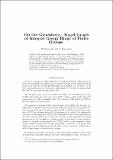On the Gruenberg–Kegel graph of integral group rings of finite groups
Abstract
The prime graph question asks whether the Gruenberg–Kegel graph of an integral group ring ℤG, i.e. the prime graph of the normalized unit group of ℤG, coincides with that one of the group G. In this note, we prove for finite groups G a reduction of the prime graph question to almost simple groups. We apply this reduction to finite groups G whose order is divisible by at most three primes and show that the Gruenberg–Kegel graph of such groups coincides with the prime graph of G.
Citation
Kimmerle , W & Konovalov , A 2017 , ' On the Gruenberg–Kegel graph of integral group rings of finite groups ' , International Journal of Algebra and Computation , vol. 27 , no. 06 , pp. 619-631 . https://doi.org/10.1142/S0218196717500308
Publication
International Journal of Algebra and Computation
Status
Peer reviewed
ISSN
0218-1967Type
Journal article
Collections
Items in the St Andrews Research Repository are protected by copyright, with all rights reserved, unless otherwise indicated.

